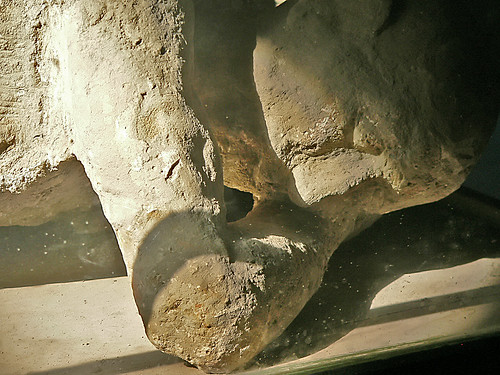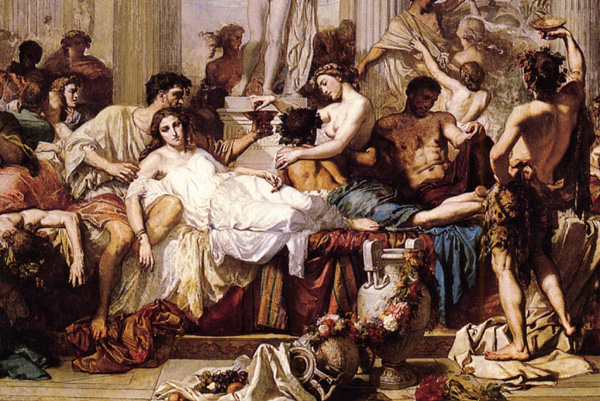 A program I saw on one of the educational channels challenged the long held belief that Cleopatra killed herself with an asp, claiming her mausoleum was too close to the palace where Octavian was staying for her to have died from a snake bite in the less than 20 minutes it took for Octavian to receive her message and rush to her death bier. Now that Dr. Zawi Hawass thinks he has discovered her mausoleum on the outskirts of modern Alexandria, much farther from her seaside palace as originally thought, perhaps the timing issue is now discredited. Anyway, I still find information about ancient poisons and the ancient drug trade fascinating. I thought this paper's mention that Nero started a School for Poisoners particularly interesting!
A program I saw on one of the educational channels challenged the long held belief that Cleopatra killed herself with an asp, claiming her mausoleum was too close to the palace where Octavian was staying for her to have died from a snake bite in the less than 20 minutes it took for Octavian to receive her message and rush to her death bier. Now that Dr. Zawi Hawass thinks he has discovered her mausoleum on the outskirts of modern Alexandria, much farther from her seaside palace as originally thought, perhaps the timing issue is now discredited. Anyway, I still find information about ancient poisons and the ancient drug trade fascinating. I thought this paper's mention that Nero started a School for Poisoners particularly interesting!By L Cilliers & F P Retief
The history of poisons and poisoning goes back about 5 000 years to the earliest
written records of the human race. Menes, first of the Pharaohs, approximately 3 000
years BC studied and cultivated poisonous and medicinal plants – an interest retained
by the Egyptian court (Smith 1952:153), until the last Pharaoh, Cleopatra, probably
died of suicide by poisoning (Retief & Cilliers 1999:8-11). The cuneiform writings of
early Mesopotamia mention the use of poisons – a topic also dealt with in the written
records of ancient India and China. Early Greek myths tell of poisoners like Medea
and Hercules’ wife Deianira, and in the 5th century BC execution by poison was
accepted in Athenian law courts. In the Hippocratic oath, nevertheless, the students of
the great master are made to swear that they will not use poison (Lloyd 1983:67). The
Persian court was proficient in the art of poisoning (Smith 1952:155), while
Mithridates VI, king of Pontus at the turn of the first century BC and Attalus III, last
king of Pergamum in the second century, experimented with poisons on condemned
prisoners (Bloch 1987: 761-763).
number of women were executed for suspected mass poisoning. Although we shall
never know its true incidence, there is good evidence that poisoning occurred more
and more frequently among all levels of society, reaching a peak in the 1st and 2nd
centuries AD. In 80 BC the dictator Sulla promulgated strict laws against poisoning.
At the end of the 1st century AD the satirist Juvenal and others denounced their
decadent society, claiming that poisoning had become a status symbol, an accepted
way for mothers to get rid of husbands and stepchildren, and for children to get rid of
rich fathers who lived too long (Juv. 1.73-76; 6.133 and 602-643; 7.169; 14.250-255).
Kaufman (1932:156) states that the word venenum (venom) is derived from
Venus and originally meant a love potion. In actual usage it later had three meanings:
remedy, poison and magic drug or abortive; in fact, venenum is such an ambiguous
word that jurists demanded that “the user of the word venenum must add whether it is
beneficial or harmful”.2 The Greek word pharmakon likewise referred to herb or drug
in general without distinguishing between its beneficial or harmful effects
(Horstmanshoff 1999:43). Veneficium meant poisoning or practicing sorcery, while
veneficus or venefica referred to a poisoner or preparer of drugs. The word scelus
(crime) is actually used by historians like Tacitus to indicate murder by poison (Ann.
1.5.2; 4.10.2; 6.33.1; 12.66.3). Poisons were also used for suicide – royalty in
particular kept a supply for emergencies (Kaufman 1932:160). Pliny considered it
quite proper for the infirm elderly to end his or her miserable life by taking poison,
and opium in particular (NH 2.197; 20.197-199).
Differentiation between producers of drugs (including poisonous substances), sellers
and prescribers of drugs in antiquity was much less clear cut than today. There were,
however, distinct intermediaries in this drug trade who played specific roles, as
summarised by Nutton (1985:138-145).
The Marsi or “travelling people” were at one end of the production chain.
Inhabiting the Abruzzi (central mountainous area of Italy), they had a reputation of
being wild and warlike with strange and archaic religious practices. They lived in
poverty, were excellent soldiers in the Roman army, but their only civilian attributes
lay in almost legendary magical powers as snake hunters and charmers, and druggists.
In many ways they were marginal people, who paid periodic visits to the cities,
selling their wares in the markets and performing daring acts as snake charmers. They
were reputed to have immunity against snake venom, and Galen admits to consulting
them on the value of drugs and antidotes. The Psylli, Nasamones and Palaeothebans
were similar peoples living elsewhere in the Mediterranean region, respected for their
skills with drugs, but frowned on by the early Christians who felt that they should not
be admitted to the flock without the greatest circumspection.
The so-called rootcutters (rhizotomoi) were much more acceptable to society
physicians and other interested parties. Some of them were recognized experts,
including the respected 1st century BC pharmacologist, Crataeus, assistant to
Mithridates. Most large cities had quarters frequented by the sellers of drugs
(including those inducing euphoric trances and poisons) and hawkers (called an
agurtês, “the man who attracts a crowd” or ochlagôgos, “seducer of the crowd”), as
well as physicians in search of remedies, and a motley crowd in search of pleasures
associated with the variety of ointments, perfumes and spices. Gradually the drug
trade became very lucrative and expanded by way of contact with the Far East, Egypt,
Arabia, North Africa and Spain. In Rome these imported products were stored in
apothecae (derived from a Greek word which literally means “storeroom”), where the
storeman (apothecarius) would list them.
Eventually the lucrativeness of the drug trade led to widespread fraud and
incompetence. Galen and others insisted that physicians should prepare their own
medicines, and not rely on herbalists to do so. As poisoning increased, there was a
growing trade in mithridatum, theriac and other so-called antidotes to poison.
However, Nutton (1985:144-145) points out that wide-spread and basic ignorance
about the action of medications led to the situation where the drug trade was
financially profitable, but from a medical point of view ineffective and even
disastrous.
As from the late 1st century BC certain persons (mostly women) became
infamous as dispensers of poison. The poet Horace (Sat. 2.1.56) tells of Canidia who
terrorized her opponents with her efficiency at poisoning.
Tacitus (Ann.
 2.69-74; 3.7) relates that when the emperor Tiberius’ nephew Germanicus died under suspicious circumstances (AD 19), it was suspected that the notorious poisoner, Martina, a close friend of Plancina, the wife of governor Piso who had quarreled with Germanicus, was partially responsible. Martina was sent to Rome where the Senate planned an
2.69-74; 3.7) relates that when the emperor Tiberius’ nephew Germanicus died under suspicious circumstances (AD 19), it was suspected that the notorious poisoner, Martina, a close friend of Plancina, the wife of governor Piso who had quarreled with Germanicus, was partially responsible. Martina was sent to Rome where the Senate planned aninvestigation into Germanicus’ death. She suddenly died on the way. Her body bore no signs of suicide, but poison was found hidden in a knot of her hair.
[Image: Death of Germanicus by Nicholas Poussin. 1628 CE]
Apollodorus, a rhetorician of Pergamum, was convicted as poisoner, but he escaped to Massilia
where he opened a school (Kaufman 1932:165). Locusta was the most infamous of these poisoners (Suet. Nero 33.3; 34; Claudius 44). Convicted of many crimes during Claudius’ reign, she was not immediately executed, and subsequently approached by Agippina, second wife of Claudius, to prepare a poison for her husband. When Claudius died, he was immediately succeeded by Nero, Agrippina’s own son – who then engaged Locusta to prepare a poison for his younger half-brother, Britannicus.
After the latter’s murder, Nero suspended Locusta’s death penalty and kept her as the emperor’s adviser on poisons. He even organized a school of poisoning where she could train others in her art. Locusta was allowed to test her poisons on animals and convicted criminals. - More





